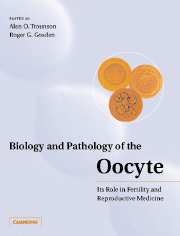Book contents
- Frontmatter
- Contents
- List of contributors
- Preface
- Part I Historical perspective
- Part II Life cycle
- 2 Ontogeny of the mammalian ovary
- 3 The early stages of follicular growth
- 4 Modelling the dynamics of ovarian follicle utilization throughout life
- 5 Comparative aspects of oogenesis
- Part III Developmental biology
- Part IV Pathology
- Part V Technology and clinical medicine
- Index
4 - Modelling the dynamics of ovarian follicle utilization throughout life
from Part II - Life cycle
Published online by Cambridge University Press: 05 August 2016
- Frontmatter
- Contents
- List of contributors
- Preface
- Part I Historical perspective
- Part II Life cycle
- 2 Ontogeny of the mammalian ovary
- 3 The early stages of follicular growth
- 4 Modelling the dynamics of ovarian follicle utilization throughout life
- 5 Comparative aspects of oogenesis
- Part III Developmental biology
- Part IV Pathology
- Part V Technology and clinical medicine
- Index
Summary
Introduction
The ovary is exceptional among the organ systems of the body because it is incompletely developed at birth and mature function does not commence until puberty - possibly months or years later, according to species. Primordial follicles are the developmental units of the ovary from which all larger stages are recruited. Entry into the growing population does not, however, guarantee successful development and ovulation, as studies of follicle dynamics reveal. The majority of follicles are wasted at all ages by the process known as atresia.
The histological appearance of the ovaries suggests that follicle development is an ordered process, both spatially and temporally. Primordial follicles are located peripherally in the ovarian cortex compared with the growing stages, the different topographic niches probably providing microenvironments with growth factors, extracellular matrix and vascularity appropriate to the stage of development. Follicle recruitment provides cohorts of growing stages from which a species-specific number of dominant stages is selected for ovulation, although this can be overridden by exogenous gonadotropins (Hillier, 2000). The process of selection of the preovulatory follicles has been called secondary recruitment and is distinct from primary recruitment, which is the initiation of primordial follicle growth and does not depend on gonadotropic stimulation (McGee and Hsueh, 2000). In a young adult woman, hundreds of follicles initiate growth during the menstrual cycle (Faddy and Gosden, 1995), but there are only 10-20 selectable antral follicles at the beginning of the cycle and, in most normal cycles, only one ripens for ovulation (Scaramuzzi et al., 1993).
Since follicle development is irreversible and unidirectional, wastage is prodigous - with the great majority of follicles even in polyovulating species undergoing the process of atresia. No follicles reach maturity under hypogonadotropic conditions, such as hypophysectomy (Jones and Krohn, 1961a) or functional deficits of the follicle-stimulating hormone (FSH) receptor resulting from spontaneous or induced mutations (Abel et al., 2000). Likewise, during physiological anovulation before puberty, as well as in pregnancy, lactation and seasonal anoestrus, follicles are arrested before maturity. This is inevitable because the transition from a nongrowing to growing follicle is independent of pituitary gonadotropins and continues without interruption from the time of establishing the follicle store. Surplus follicles must be eliminated to avoid accumulating and possibly creating a dangerous hypertrophy of the ovary.
- Type
- Chapter
- Information
- Biology and Pathology of the OocyteIts Role in Fertility and Reproductive Medicine, pp. 44 - 52Publisher: Cambridge University PressPrint publication year: 2003
- 15
- Cited by



